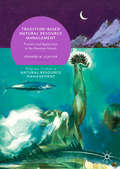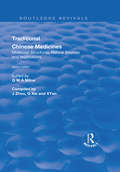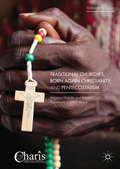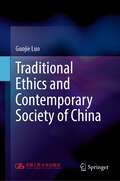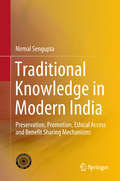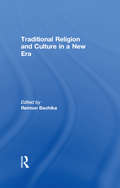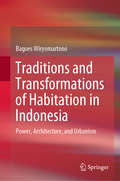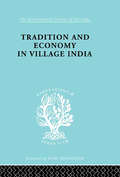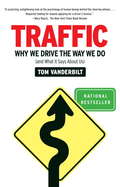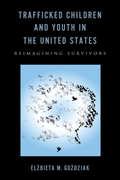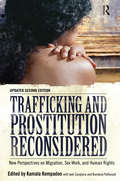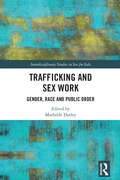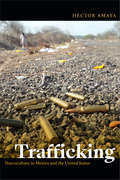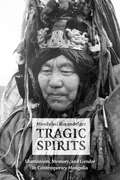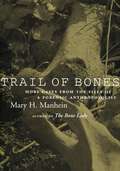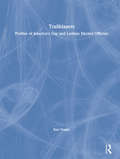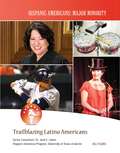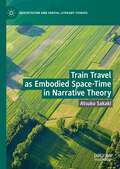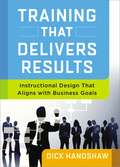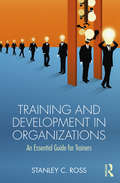- Table View
- List View
Tradition-Based Natural Resource Management: Practice and Application in the Hawaiian Islands (Palgrave Studies in Natural Resource Management)
by Edward W. GlazierThis book addresses the complex socio-political context of natural resource management in coastal and marine environments throughout the contemporary Pacific Islands and provides lessons that can be applied around the globe. The author spotlights one particular case in which Native Hawaiians worked successfully to develop a formal policy mechanism through which to advise government agencies in the State of Hawaii on matters regarding traditional and customary use and management of the island’s natural resources. Glazier describes historic-traditional aspects of natural resource use and management in the Hawaiian Islands and the challenging process that was employed to enhance the capacity of modern Hawaiians to influence the course of their future. This process successfully broached and addressed truly difficult challenges, including but not limited to: the convening of representatives of a complex society of indigenous persons in order to elicit traditional place-based knowledge and varying perspectives on the appropriate use and management of natural resources; the incorporation of such knowledge and perspectives into the modern natural resource management and policy context; and the need to balance the interests of indigenous persons and those of more recently-arriving persons around the island chain. The lessons learned were many and varied and are particularly germane for resource managers, scientists, policymakers, and indigenous persons seeking to undertake balanced natural resource policy decisions in island, coastal, and indigenous settings around the Pacific and beyond.
Traditional Chinese Medicines: Molecular Structures, Natural Sources and Applications
by J Zhou G Xie X Yan G W A MilneThis title was first published in 2003. In laboratories around the world the active principles in traditional herbal medicines are being isolated and characterized. A systematic effort at the Chinese Academy of Sciences is underway to identify the structure-activity relationships that result from the link between chemistry and medicine that is permitted by this data. This book, which provides the only systematic English-language description of the chemical structures and pharmacological effects of compounds active in traditional Chinese medicines (TCMs), is now in its second edition. The new edition provides English-language monographs on over 9000 chemicals isolated from nearly 4000 natural sources used in Chinese medicine and features the addition of in-depth bioactivity data for many of the compounds. Effects and indications of the medicines are included. Extensive indexing permits cross-referencing among English, Chinese and Latin names for natural medicinal sources, effects and indications, and the chemical components of the medicines. The second edition of Traditional Chinese Medicines includes 2300 new compounds, 2400 additional plant sources, more CAS Registry Numbers, and more pharmacological data. The structure of the book has been extensively reorganised to make cross referencing the data much simpler. This new edition is therefore a substantial improvement on the first edition of this important reference on the structural chemistry of traditional Chinese medicines.
Traditional Chinese Thinking On Hrm Practices
by Li YuanSuggests important ramifications for both Western and Eastern Human Resources Practices and is the first research of its kind to empirically investigate the effect of Chinese core values, which originated from Chinese traditional thinking, on HRM practices in China.
Traditional Churches, Born Again Christianity, and Pentecostalism: Religious Mobility and Religious Repertoires in Urban Kenya (Christianity and Renewal - Interdisciplinary Studies)
by Yonatan N. GezIn Kenya's vibrant urban religious landscape, where Pentecostal and traditional churches of various orientations live side by side, religious identity tends to overflow a single institutional affiliation. While Kenya’s Christianity may offer modes of coping with the fragilities of urban life, it is subject to repeated crises and schisms, often fueled by rumors and accusations of hypocrisy. In order to understand the unfolding of Kenyans’ dynamic religious identities, and inspired by the omnipresent distinction between ‘religious membership’ and ‘church visits,’ Yonatan N. Gez considers the complementary relations between a center of religious affiliation and expansion towards secondary practices. Building on this basic distinction, the book develops a theoretical innovation in the form of the ‘religious repertoire’ model, which maps individuals’ religious identities in terms of three intertwined degrees of practice.
Traditional Ethics and Contemporary Society of China
by Guojie LuoBased on the ethical thinking of the pre-Qin Dynasty, this book discusses the formation and development of traditional Chinese ethics, the refinement of the Confucian ethical normative system and the establishment of its orthodoxy, as well as the deepening and maturation of feudal ethics. The book is simple in style and clear in context. It contains not only the essence of traditional Chinese morality but also the achievements of modern civilization. It analyzes the implications of traditional Chinese ethics on the governance and moral construction of modern society and can be used as a reference for governance and revitalization of the country and moral development.
Traditional Knowledge in Modern India: Preservation, Promotion, Ethical Access and Benefit Sharing Mechanisms
by Nirmal SenguptaThis book demonstrates how traditional knowledge can be connected to the modern world. Human knowledge of housing, health and agriculture dates back thousands of years, with old wisdom developing and becoming modern. But in the past few decades, global communities have increasingly become aware that some of this valuable knowledge has fallen by the wayside. This has sparked systematic efforts at the local, national and global levels to connect this neglected knowledge to the modern world.It discusses the origin of the topic, its importance, recent developments in India and abroad, and what is being done and still needs to be done in order to preserve India’s traditional knowledge. The discussions address a broad range of fields and organizations: from Basmati rice to Ayurvedic cosmetics; from traditional irrigation and folk music to modern drug discovery and climate change adaptation; and from the Biodiversity Convention to the WHO, WTO and WIPO.
Traditional Rainwater Harvesting Structures (SpringerBriefs in Water Science and Technology)
by Joji V.S. Reshma Susan JacobThis book contains detailed information about the traditional rainwater structures. Harvesting rainwater is becoming as a practical adaptation strategy for urban areas that are vulnerable to climate alteration. In the past, rainwater harvesting was more significant than it is today. Studies show that a variety of traditional and age-old rainwater gathering techniques were created or put into use in reaction to earlier climate change incidents. According to history, both floods and droughts were frequent occurrences in ancient India. Perhaps this explains why each region of the nation has its own traditional water gathering practices that are representative of the local physical and cultural diversity. All of these methods can be seen as a concept of harvesting rain whenever and wherever it falls. Water makes up 70.9 % of the Earth's surface, mainly in the form of oceans and seas. Water is found in modest proportions as 1.7 % groundwater, 1.7 % glaciers and ice caps in Antarctica and Greenland, vapour, clouds (ice and liquid water suspended in air), and 0.001% precipitation in the air. Evaporation, transpiration, evapo-transpiration, condensation, precipitation, root absorption, percolation, infiltration, base flow and runoff are processes that water goes through on its way to the sea.
Traditional Religion and Culture in a New Era
by Reimon BachikaWhere will postmodern culture lead us in the twenty-first century? Will it destroy traditional cultures together with the old, established religions that were its foundation? These questions and the new concerns they evoke are explored in this important collection of original essays. Contributors challenge entrenched assumptions about what many social scientists consider irreversible cultural trends. These include cultural differentiation, emphasis on individual identity, movement toward religion as a private act rather than a community commitment, and above all, emphasis on the relativity of all knowledge and values.The volume asserts three lines of argument in opposition to these trends. The first is the teleological significance of traditional religions and archaic knowledge. History can be said to have no goal, but the same must not follow for human culture. One can conceive individually of a hundred goals to live for. However, the quality of life cannot be that diverse. Taken to the extreme, cultural particularity and philosophical nihilism are insults to the life that emerged on our planet eons ago. Second, this volume emphasizes moral concern and the importance of universal values. Ideas of human well being have been formulated from ancient times. Religious beliefs invariably contain statements of value in the form of commandments and exhortations that express fundamental goals for a quality of life. Third, the nature of religion and spirituality is discussed. Religion today has become controversial socially, and marginal sociologically. The role of religion in society is sometimes problematic or abused, but it is also underestimated and misunderstood. The authors suggest that contemporary religion might best be viewed as non-ideological spiritual culture. This, in turn, looks to a future in which religion and culture coalesce.This volume includes an international cast of scholars from Japan, the United States, Canada, the United Kingdom, Germany, Greece, Italy, New Zealand, and Belgium. All have engaged in research outside their own countries. Taken as a whole, this volume addresses issues of interest to those in the fields of futures studies, religion, and philosophy, and in particular those concerned with human agency, personal responsibility, and public choice.
Traditionen juristisch-notarieller Textproduktion durch Translation: Zapotekisch-spanische Gerichtsakten in Neu-Spanien (Übersetzungskulturen der Frühen Neuzeit #6)
by Malte KneifelDieses Open Access-Buch bietet eine historisch ausgerichtete Untersuchung juristisch-notarieller Dokumente aus Neu-Spanien an der Schnittstelle zwischen romanistischer Textlinguistik und Translationswissenschaft. Konkret wird ein umfassendes Korpus aus Texten der indigenen Selbstverwaltung und Rechtsprechung analysiert, die in einer peripheren Region des kolonialen Mexiko zwischen dem 17. und 18. Jahrhundert in der indigenen Sprache Zapotekisch verfasst und zur Weitergabe an die spanisch-koloniale Gerichtsbarkeit ins Spanische übersetzt wurden. Grundlage der Analyse ist ein Modell, das textlinguistische und translationswissenschaftliche Ansätze integriert, darunter das Konzept der Diskurstraditionen und die Descriptive Translation Studies. Die Untersuchung liefert Erkenntnisse über die Entstehung und Entwicklung konkreter Traditionen der Produktion von Fachtexten innerhalb eines komplexen historischen Kontextes, für die Translation sowie deren Rezeption und Antizipation einen wesentlichen treibenden Faktor darstellen. Das Buch bietet damit nicht nur eine linguistische Aufarbeitung von aus dieser Perspektive bisher wenig bearbeiteten historischen, mehrsprachigen Dokumenten der spanischen Kolonialzeit, sondern trägt auch zu einer Integration von (romanistisch-)textlinguistischen und translationswissenschaftlichen Theorien für die Anwendung in konkreten historischen Forschungen bei. Es richtet sich somit an alle am Forschungsgegenstand Interessierten sowie an Textlinguist*innen und Translationswissenschaftler*innen, die ihr Forschungsfeld an ebendieser Schnittstelle verorten.
Traditions and Transformations of Habitation in Indonesia: Power, Architecture, and Urbanism
by Bagoes WiryomartonoThis book raises the issue of the practice of patrimonial power with a focus on habitations, particularly in the urban areas of Indonesia. An assemblage of interdisciplinary studies within the framework of environmental humanities, covering the arts, architecture, urban studies, geography, cultural anthropology, and sociology, this multifaceted framework divulges the interactive connectivity between Indonesia’s patrimonial culture and the socio-culturally constructed system of habitation. The interdisciplinary study of the pertinent practices of patrimonial power that have been represented and been manifested by various political and traditional regimes in terms of the built environment and habitation in Indonesia contributes to a new understanding of Indonesian urban spatial development, from the pre-colonial era to the present. The book poses that in order to understand the politics of Indonesia, one must understand the culture and tradition of the political leadership of the country. The author presents such an understanding in exploring and unpacking the relationship between people and place that constructs, develops, sustains, and conserves Indonesian culture and traditions of habitation. This book is of interest to graduate scholars and researchers in Asian Studies in numerous disciplines, including urban studies, urban planning and design, political science, architecture, anthropology of space, public administration, and political philosophy.
Traditn Econ Vill Ind Ils 74 (International Library of Sociology)
by K. IshwaranFirst published in 1998. Routledge is an imprint of Taylor & Francis, an informa company.
Traffic: Why We Drive The Way We Do (and What It Says About Us)
by Tom VanderbiltWould you be surprised that road rage can be good for society? Or that most crashes happen on sunny, dry days? That our minds can trick us into thinking the next lane is moving faster? Or that you can gauge a nation’s driving behavior by its levels of corruption? These are only a few of the remarkable dynamics that Tom Vanderbilt explores in this fascinating tour through the mysteries of the road. Based on exhaustive research and interviews with driving experts and traffic officials around the globe,Trafficgets under the hood of the everyday activity of driving to uncover the surprisingly complex web of physical, psychological, and technical factors that explain how traffic works, why we drive the way we do, and what our driving says about us. Vanderbilt examines the perceptual limits and cognitive underpinnings that make us worse drivers than we think we are. He demonstrates why plans to protect pedestrians from cars often lead to more accidents. He shows how roundabouts, which can feel dangerous and chaotic, actually make roads safer—and reduce traffic in the bargain. He uncovers who is more likely to honk at whom, and why. He explains why traffic jams form, outlines the unintended consequences of our quest for safety, and even identifies the most common mistake drivers make in parking lots. The car has long been a central part of American life; whether we see it as a symbol of freedom or a symptom of sprawl, we define ourselves by what and how we drive. As Vanderbilt shows, driving is a provocatively revealing prism for examining how our minds work and the ways in which we interact with one another. Ultimately,Trafficis about more than driving: it’s about human nature. This book will change the way we see ourselves and the world around us. And who knows? It may even make us better drivers.
Trafficked Children and Youth in the United States: Reimagining Survivors
by Elzbieta M. GozdziakTrafficked children are portrayed by the media--and even by child welfare specialists--as hapless victims who are forced to migrate from a poor country to the United States, where they serve as sex slaves. But as Elzbieta M. Gozdziak reveals in Trafficked Children in the United States, the picture is far more complex. Basing her observations on research with 140 children, most of them girls, from countries all over the globe, Gozdziak debunks many myths and uncovers the realities of the captivity, rescue, and rehabilitation of trafficked children. She shows, for instance, that none of the girls and boys portrayed in this book were kidnapped or physically forced to accompany their traffickers. In many instances, parents, or smugglers paid by family members, brought the girls to the U.S. Without exception, the girls and boys in this study believed they were coming to the States to find employment and in some cases educational opportunities. Following them from the time they were trafficked to their years as young adults, Gozdziak gives the children a voice so they can offer their own perspective on rebuilding their lives--getting jobs, learning English, developing friendships, and finding love. Gozdziak looks too at how the children's perspectives compare to the ideas of child welfare programs, noting that the children focus on survival techniques while the institutions focus, not helpfully, on vulnerability and pathology. Gozdziak concludes that the services provided by institutions are in effect a one-size-fits-all, trauma-based model, one that ignores the diversity of experience among trafficked children. Breaking new ground, Trafficked Children in the United States offers a fresh take on what matters most to these young people as they rebuild their lives in America.
Trafficking and Prostitution Reconsidered: New Perspectives on Migration, Sex Work, and Human Rights
by Kamala Kempadoo Jyoti Sanghera Bandana PattanaikSince the 2005 publication of the highly acclaimed first edition of Trafficking and Prostitution Reconsidered, human trafficking has become virtually a household phrase. This new edition adds vitally important updates related to recent developments. A new introduction considers the term 'sex trafficking' and its growing use amongst feminist researchers. In a new chapter Ratna Kapur looks at changes in anti-trafficking legislation especially under the Obama administration. Jyoti Sanghera reports from her experience as a UN Human Rights commissioner and Bandana Pattanaik examines feminist participatory research on 'trafficking'. The book concludes with a list of relevant websites, organisations, and publications useful for students, researchers, and activists.
Trafficking and Sex Work: Gender, Race and Public Order (Interdisciplinary Studies in Sex for Sale)
by Mathilde DarleySet in different national contexts (Brazil, Bulgaria, France, Germany, Laos, Norway, Thailand) and in different social science disciplines, the chapters of this volume aim at questioning anti-trafficking policies and their practical impact on sex work regulation. Many actors, from media to researchers, from nonprofit organizations to law enforcement agencies, from "experts" to "reality tourists", contribute to produce knowledge on trafficking and sexual exploitation and thus to institutionalize it as a category of thought and action; by naming and framing perpetrators and victims, they make trafficking "come true" as a public problem. The book pays particular attention to the way the international expertise produced by these different actors and institutions on sexual exploitation and sex work impacts local control practices, especially with regard to law enforcement. The fight against trafficking as it gets institutionalized and put into practice then appears as a way to reaffirm a gendered and racialized public order. Building analytical bridges between different national contexts and relying on contextualized fieldwork in different countries, the book is of great interest for academics as well as for practitioners and/or activists working on sex and gender issues and migration policies. Also, it resonates with a broader literature on the construction of public problems in sociology and political science.
Trafficking: Narcoculture in Mexico and the United States
by Hector AmayaIn Trafficking Hector Amaya examines how the dramatic escalation of drug violence in Mexico in 2008 prompted new forms of participation in public culture in Mexico and the United States. He contends that, by becoming a site of national and transnational debate about the role of the state, this violence altered the modes publicness could take, transforming assumptions about freedom of expression and the rules of public participation. Amaya examines the practices of narcocorrido musicians who take advantage of digital production and distribution technologies to escape Mexican censors and to share music across the US-Mexico border, as well as anonymous bloggers whose coverage of trafficking and violence from a place of relative safety made them public heroes. These new forms of being in the public sphere, Amaya demonstrates, evolved to exceed the bounds of the state and traditional media sources, signaling the inadequacy of democratic theories of freedom and publicness to understand how violence shapes public discourse.
Tragic Spirits: Shamanism, Memory, and Gender in Contemporary Mongolia
by Manduhai BuyandelgerA “highly readable ethnographic study” of the resurgence of shamanism among nomadic Mongolians in a time of radical political and economic change (The Journal of Asian Studies).Winner, Francis Hsu Book Prize from the Society for East Asian AnthropologyShortlisted, ICAS (International Convention of Asia Scholars) Book PrizeThe collapse of socialism at the end of the twentieth century brought devastating changes to Mongolia. Economic shock therapy—an immediate liberalization of trade and privatization of publicly owned assets—quickly led to impoverishment, especially in rural parts of the country, where Tragic Spirits takes place. Following the travels of the nomadic Buryats, Manduhai Buyandelger tells a story not only of economic devastation but also a remarkable Buryat response to it—the revival of shamanic practices after decades of socialist suppression. Attributing their current misfortunes to returning ancestral spirits who are vengeful over being abandoned under socialism, the Buryats are now at once trying to appease their ancestors and recover the history of their people through shamanic practice. Thoroughly documenting this process, Buyandelger situates it as part of a global phenomenon, comparing the rise of shamanism in liberalized Mongolia to its similar rise in Africa and Indonesia. In doing so, she offers a sophisticated analysis of the way economics, politics, gender, and other factors influence the spirit world and the crucial workings of cultural memory.“An excellent addition to studies in the area . . . emotive, accessible and well-researched.” —London School of Economics Review of Books
Trail of Bones: More Cases from the Files of a Forensic Anthropologist
by Mary H. ManheinA fellow of the American Academy of Forensic Sciences and an expert on the human skeleton, Mary H. Manhein assists law enforcement officials across the country in identifying bodies and solving criminal cases. In Trail of Bones, her much-anticipated sequel to The Bone Lady, Manhein reveals the everyday realities of forensic anthropology. Going beyond the stereotypes portrayed on television, this real-life crime scene investigator unveils a gritty, exhausting, exacting, alternately rewarding and frustrating world where teamwork supersedes individual heroics and some cases unfortunately remain unsolved. A natural storyteller, Manhein provides gripping accounts of dozens of cases from her twenty-four-year career. Some of them are famous. She describes her involvement in the hunt for two serial killers who simultaneously terrorized the Baton Rouge, Louisiana, region for years; her efforts to recover the remains of the seven astronauts killed in the Columbia space shuttle crash in 2003; and her ultimately successful struggle to identify the beheaded toddler known for years as Precious Doe. Less well-known but equally compelling are cases involving the remains of a Korean War soldier buried for more than forty years and the mystery of “Mardi Gras Man,” who was wearing a string of plastic beads when his body was discovered. Manhein describes how the increased popularity of tattoos has aided her work and how forensic science has labored to expose frauds—including a fake “big foot” track she examined from Louisiana's Kisatchie National Forest. She also shares ambitious plans to create a database of biological and DNA profiles of all of the state's missing and unidentified persons. Possessing both compassion and tenacity, Mary Manhein has an extraordinary gift for telling a life story through bones. Trail of Bones takes readers on an entertaining and educating walk in the shoes of this remarkable scientist who has dedicated her life to providing justice for those no longer able to speak for themselves.
Trailblazers: Profiles of America's Gay and Lesbian Elected Officials
by Kenneth S YeagerTrailblazers: Profiles of America’s Gay and Lesbian Elected Officials (winner of the Victory Foundation Civic Leadership Award) is a quick reference to the most comprehensive list of the country’s openly gay and lesbian officials. You’ll read about 14 of these representatives in greater depth, getting to know them personally and professionally. Trailblazers identifies representatives from local, state, and national levels from all over the country. In each profile, you’ll examine the relationship between the elected official and his or her constituency. You’ll also explore public reactions to openly gay and lesbian politicians, some of whom are also ethnic minorities, and how this affects the job that they do. Trailblazers offers an in-depth, personal look at the lives of some of the politicians involved in the history of gay and lesbian activism over the last 20 years. Specifically, you’ll read about the lives of: Tina Podloski, a lesbian mother and Seattle Councilwoman Tom Duane, a New York Councilman with HIV Sabrina Sojourner, an African-American lesbian shadow representative in Washington, DC William Weybourn, the founder of the Gay and Lesbian Victory Fund, which helps to elect gay and lesbian candidates to public office Jose Plata, a gay Hispanic Dallas School TrusteeIn addition to giving you keen insight into the lives of these officials, Trailblazers can help you if you decide to run for election, putting a checklist of campaign dos and don’ts at your fingertips. An enlightening book about the private and public achievements of our gay and lesbian politicians, Trailblazers is a valuable addition to any personal or professional library.
Trailblazing Latino Americans (Hispanic Americans: Major Minority)
by Bill PalmerAccording to U.S. Census Bureau, Latinos will make up two-thirds of the population growth in the United States for the first half of the twenty-first century. At this rate, Latinos will number 80 million by the year 2050! This growing part of America's population makes the United States a more exciting place. Hispanic athletes lead the way in American sports. Moviegoers flock to see Latinas and Latinos in movies. Other Hispanic Americans have gained fame for their television roles. Latin rhythms can be heard every hour on pop radio stations. And a growing number of Latino politicians are taking their place in America's government. Learn the stories of some of these trailblazers!
Trailer Park America: Reimagining Working-Class Communities
by Leontina HormelIn rural northern Idaho in the winter of 2013-2014, Syringa Mobile Home Park’s water system was contaminated by sewage, resulting in residents’ water being shut off for 93 days. By summer 2018 Syringa had closed, forcing residents to relocate or face homelessness. Trailer Park America chronicles how residents dealt with regulatory agencies, frequent boil order notices, threats of closure, and class-based social stigma over this period. Despite all this, what was seen as a dysfunctional, ‘disorderly’ community by outsiders was instead a refuge where veterans, women heads of households, and people with disabilities or substance use disorders were supported and understood. The embattled Syringa community also organized to defend the rights and dignity of residents and served as a site for negotiating with local government, culminating in a class-action lawsuit that reached the federal level. The experiences Syringa residents faced in this conservative, predominately white region of the United States are emblematic of the growing national and global crisis in affordable housing and home ownership, with declining work conditions and incomes for the working-class.
Train Travel as Embodied Space-Time in Narrative Theory (Geocriticism and Spatial Literary Studies)
by Atsuko SakakiTrain Travel as Embodied Space-Time in Narrative Theory argues that the train is a loaded trope for reconfiguring narrative theories past their “spatial turn.” Atsuko Sakaki’s method exploits intensive and rigorous close reading of literary and cinematic narratives on one hand, and on the other hand interdisciplinary perspectives that draw out larger connections to narrative theory. The book utilizes not only narratological frameworks but also concepts of space-focused humanity oriented social sciences, such as human geography, mobility studies, tourism studies, and qualitative/experience-based ethnography, in their post “narrative turn.” On this interface of narrative studies and spatial studies, this book pays concerted attention to the formation of affordances, or relations in which the human subject uses a space-time and things in it, in terms of passenger experience of the train carriage and its extension. Affiliation: Atsuko Sakaki, University of Toronto, Toronto, Canada.
Train Up a Child: Old Order Amish and Mennonite Schools (Young Center Books in Anabaptist and Pietist Studies)
by Karen M. Johnson-WeinerTrain Up a Child explores how private schools in Old Order Amish communities reflect and perpetuate church-community values and identity. Here, Karen M. Johnson-Weiner asserts that the reinforcement of those values among children is imperative to the survival of these communities in the modern world. Surveying settlements in Indiana, Michigan, Ohio, Pennsylvania, and New York, Johnson-Weiner finds that, although Old Order communities have certain similarities in their codes of conduct, there is no standard Old Order school. She examines the choices each community makes—about pedagogy, curriculum, textbooks, even school design—to strengthen religious ideology, preserve the social and linguistic markers of Old Order identity, and protect their own community's beliefs and values from the influence of the dominant society. In the most comprehensive study of Old Order schools to date, Johnson-Weiner provides valuable insight into how variables such as community size and relationship with other Old Order groups affect the role of these schools in maintaining behavioral norms and in shaping the Old Order's response to modernity.
Training That Delivers Results: Instructional Design That Aligns with Business Goals
by Dick HandshawInstructional designers and other training professionals are often forced into order-taking roles. The company wants training on a specific topic--business writing, behavioral interviewing, customer service--and a one-size-fits-all module is produced. Training That Delivers Results offers a far better way to educate employees, one that connects learning solutions with strategic business goals. Rather than being told what to teach, proactive designers collect data to define problems and develop training interventions. Written by one of the originators of computer-based training, Handshaw's results-oriented model is systematic, yet flexible, and works for both instructor-led training and e-learning. Readers will learn how to: Analyze performance gaps Create targeted performance objectives and connect them with the right measurement tools Determine the best instructional strategy and the appropriate media Build consensus with project blueprint meetings Evaluate the effectiveness of training and use the data to continually improve. Learning goals and business goals should go hand in hand. Here are the tools, worksheets, and assessments needed to tie the learning experience to enhanced performance outcomes--and deliver sustainable, quantifiable business results.
Training and Development in Organizations: An Essential Guide For Trainers
by Stanley C. Ross<p>Training and Development in Organizations introduces students to the field of training and development, showcasing how the role and function of training within an organization supports the organization’s efforts at fulfilling its mission. <p>Focusing on six themes – strategic view; training paradigm; training model; types of training; rubrics; and andragogy, a theory focused specifically on the adult learner – the author offers an applied approach to designing and implementing a training program. Readers will learn about different types of training programs, ranging from simple to complex, while a model program design demonstrates the critical elements associated with designing a program, such as subjects, time frame, learning objectives, and more. Practical exercises and thought-provoking end of chapter questions help students learn how to apply the concepts successfully, while Chapter Twelve specifically includes a variety of practical exercises for use in application-oriented assignments. <p>Undergraduate students of human resource management, and training and development, as well as business managers seeking to develop their training knowledge, will appreciate this commonsense treatment of the subject.</p>
